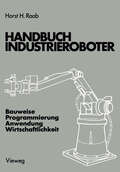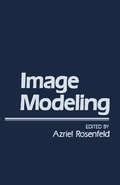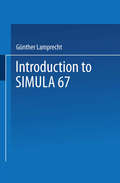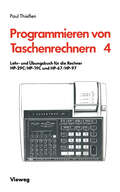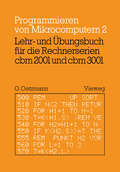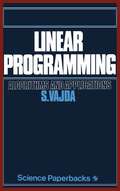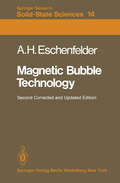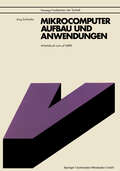- Table View
- List View
Handbuch Industrieroboter: Bauweise · Programmierung Anwendung · Wirtschaftlichkeit
by Horst H. RaabIndustrieroboter sind universelle Handhabungsgeräte mit mehreren Freiheitsgraden, die freiprogrammierbar und damit leicht umrüstbar sind. Ihre Entwicklung wurde vornehmlich durch zwei Tendenzen begleitet und geprägt: Da ist einmal die Notwendigkeit, in der Fertigung eine immer größere Anzahl kleiner werdender Losgrößen auch in der Handhabungstechnik zu automatisieren. Da ist zum anderen der ungeheuere Fortschritt in der elektronischen Steuerungstechnik, der zu erhöhter Flexibilität und besserer technischer Ausstattung der Industrieroboter führte. Eine Fülle von Veröffentlichungen befaßt sich mit allen Einzelheiten über Industrieroboter. Das "Handbuch Industrieroboter" versucht dem an der Praxis orientierten Anwender diese neue Technologie aus neutraler Sicht in einem möglichst umfassenden Stand zu umreißen. Das kann, unter Voraussetzung eines vernünftigen Umfanges für dieses Buch, nur durch viele Abbildungen, knappem Text, Tabellen und Übersichten sowie durch Beschränkung auf die Anwendungsorientiertheit geschehen. Aus diesem Grunde wurden bewußt beim Datenteil nur Industrieroboter aufgenommen, die vornehmlich in Deutschland vertrieben werden. Nach Erörterung von Gründen für die Automatisierung mit Industrierobotern, befaßt sich das Buch mit Vor- und Nachteilen der unterschiedlichen Bauteile und Bauweisen dieser Geräte. Daran anschließend folgen Anwendungsfälle aus der Praxis. Nach Programmierung und Einsatzplanung von diesen freiprogrammierbaren Handhabungsautomaten, wird schließ lich an zwei konkreten Fallstudien ein Wirtschaftlichkeitsvergleich auf der elektronischen Datenverarbeitung durchgeführt. Zukünftigen Entwicklungen wird nur ein kurzer Ausblick gewährt. Dafür schließen umfang reiche Tabellen und Abbildungen von maßstäblichen Arbeitsräumen aller gebräuchlichen Geräte das Buch ab.
History of Computing in the Twentieth Century
by Nicholas MetropolisHistory of Computing in the Twentieth Century
Image Modeling
by Azriel RosenfeldImage Modeling compiles papers presented at a workshop on image modeling in Rosemont, Illinois on August 6-7, 1979.This book discusses the mosaic models for textures, image segmentation as an estimation problem, and comparative analysis of line-drawing modeling schemes. The statistical models for the image restoration problem, use of Markov random fields as models of texture, and mathematical models of graphics are also elaborated. This text likewise covers the univariate and multivariate random field models for images, stochastic image models generated by random tessellations of the plane, and long crested wave models. Other topics include the Boolean model and random sets, structural basis for image description, and structure in co-occurrence matrices for texture analysis.This publication is useful to specialists and professionals working in the field of image processing.
Image Sequence Analysis (Springer Series in Information Sciences #5)
by T. S. HuangThe processing of image sequences has a broad spectrum of important applica tions including target tracking, robot navigation, bandwidth compression of TV conferencing video signals, studying the motion of biological cells using microcinematography, cloud tracking, and highway traffic monitoring. Image sequence processing involves a large amount of data. However, because of the progress in computer, LSI, and VLSI technologies, we have now reached a stage when many useful processing tasks can be done in a reasonable amount of time. As a result, research and development activities in image sequence analysis have recently been growing at a rapid pace. An IEEE Computer Society Workshop on Computer Analysis of Time-Varying Imagery was held in Philadelphia, April 5-6, 1979. A related special issue of the IEEE Transactions on Pattern Anal ysis and Machine Intelligence was published in November 1980. The IEEE Com puter magazine has also published a special issue on the subject in 1981. The purpose of this book is to survey the field of image sequence analysis and to discuss in depth a number of important selected topics. The seven chap ters fall into two categories. Chapters 2, 3, and 7 are comprehensive surveys on, respectively, the whole field of image sequence analysis, efficient coding of image sequences, and the processing of medical image sequences. In Chapters 1, 4, 5, and 6 the authors present mainly results of their own research on, respectively, motion estimation, noise reduction in image sequences, moving object extraction, and occlusion.
Interaktives Programmsystem zur Erstellung von Fertigungsunterlagen für die Kaltmassivumformung (IFU - Berichte aus dem Institut für Umformtechnik der Universität Stuttgart #60)
by Michael RebholzIntersensory Perception and Sensory Integration (Perception and Perceptual Development #2)
by Richard D. Walk Herbert L. PickThis volume on intersensory perception and sensory integration is the second volume of the series, Perception and Perceptual Development: A Critical Review Series. The topic of the volume is timely, for in recent years, many investigators have noted that information about any natural event is obtained by a perceiver from a variety of sources. Such an observation immediately leads to the question of how this information is synthesized and organized. Of course, the implication that there are several discrete input channels that must be processed has come under immediate attack by researchers such as the Gibsons. They find it extremely artificial to regard natural information as being cut up and requiring cementing. Nevertheless, the possibility that during ontogene sis, perception involves the integration of separate information has attracted the attention of scholars concerned with both normal and abnormal development. In the case of normal development, a lively controversy has arisen between those who believe perceptual develop ment goes from integration toward differentiation and those who hold the opposite view. In the case of abnormal psychological development such as learning disabilities, many workers have suggested that percep tual integration is at fault. In thinking about the issues raised in this volume, we are particularly indebted to our former teachers and colleagues: Eleanor and James Gibson, T. A. Ryan, Robert B. MacLeod, and Jerome Bruner. We are pleased to acknowledge the secretarial help of Karen Weeks in the preparation of this volume.
Kommunikation in verteilten Systemen: Fachtagung der GI, Berlin, 27.–30. Januar 1981 (Informatik-Fachberichte #40)
by S. Schindler J. C. W. SchröderLehr- und Übungsbuch für die Rechner HP-29C/HP-19C und HP-67/HP-97 (Programmieren von Taschenrechnern #4 )
by Paul A. ThießenLehr- und Übungsbuch für die Rechnerserien cbm 2001 und cbm 3001 (Programmieren von Mikrocomputern #2)
by Gerhard OetzmannMikrocomputer erfreuen sich wachsender Beliebtheit, was nicht zuletzt darin begründet ist, daß sie in einer höheren Programmiersprache, meistens BASIC, programmiert werden kön nen. Diese Sprache ist in ihrem Kern standardisiert, aber jeder Rechnerhersteller hat zusätz liche Anweisungsarten integriert. Wer effektvoll programmieren will, muß also die auf sei nen Rechner ausgerichtete Variante des BASIC beherrschen. Dieses Buch wendet sich an Leser, die lernen wollen, einen Commodore-Rechner der Se rien cbm 2001 oder cbm 3001 in BASIC zu programmieren. Dabei ist ein regelmäßiges, ak tives Arbeiten an einem entsprechenden Rechner unverzichtbar. Deshalb sollten die zahl reichen Experimente unbedingt durchgeführt und die Aufgaben, soweit das möglich ist, am Rechner gelöst werden. Vorkenntnisse über Aufbau und Funktionsweise von Digitalrechnern sind nicht unbedingt erforderlich. Da die Eigenarten der Programmierung sich an mathematischen Problemen be sonders einfach demonstrieren lassen, werden geringe Mathematikkenntnisse vorausgesetzt, die sich im wesentlichen auf die Grundlagen der Algebra beschränken. Zu danken habe ich meiner Frau für die umfassende Unterstützung und die übernahme der Schreibarbeiten. Ich danke auch der Geschäftsführung der DATENREVISION Beratungs gesellschaft, Hamburg 90, die die Entstehung dieses Buches durch die vorübergehende über lassung einer cbm-Rechenanlage gefördert hat. Nicht zuletzt gilt mein Dank den Mitarbei tern des Verlages für die reibungslose Zusammenarbeit. G.Oetzmann Hamburg, im Frühjahr 1981 1 Was ist BASIC? Charakteristisch für einen frei programmierbaren Digitalrechner ist die Trennung der Ar beitsanweisung (des Programms) von der ausführenden Anlage. Dadurch wird es möglich, einer Anlage durch Wechsel des Programms immer wieder neue Aufgaben zu übertragen.
Linear Programming: Algorithms and applications
by S. VajdaThis text is based on a course of about 16 hours lectures to students of mathematics, statistics, and/or operational research. It is intended to introduce readers to the very wide range of applicability of linear programming, covering problems of manage ment, administration, transportation and a number of other uses which are mentioned in their context. The emphasis is on numerical algorithms, which are illustrated by examples of such modest size that the solutions can be obtained using pen and paper. It is clear that these methods, if applied to larger problems, can also be carried out on automatic (electronic) computers. Commercially available computer packages are, in fact, mainly based on algorithms explained in this book. The author is convinced that the user of these algorithms ought to be knowledgeable about the underlying theory. Therefore this volume is not merely addressed to the practitioner, but also to the mathematician who is interested in relatively new developments in algebraic theory and in some combinatorial theory as well. The chapters on duality, and on flow in networks, are particularly directed towards this aim and they contain theorems which might not be directly relevant to methods of computation. The application of the concept of duality to the theory of games is of historical interest. It is hoped that the figures, which illustrate the results, will be found illuminating by readers with active geometrical imagination.
Magnetic Bubble Technology (Springer Series in Solid-State Sciences #14)
by A. H. EschenfelderThe popularity of the First Edition of this book has been very gratifying. It confirms that there is a genuine need for a text covering the magnetic bubble technology. We are pleased that the readers have found that this book satisfies that need. It has been used as a text for courses in both universities and industry, and as a reference manual by workers active in the field. To meet the need for more copies of the book it seemed preferable to publish a second edition rather than merely a second printing. There has been some significant progress, even in the short time since the initial printing, and we wanted to include that. At the same time we would like to provide the new copies at the lowest possible cost so that they are more easily obtained by students. For this reason the new edition is in soft cover and the recent progress has been described in a final chapter rather than incorporated into the original chapters. This eliminates the expense of resetting and repaging the original text. At the same time up-to-date references have been added and typographical errors have been corrected in the original chapters. It is our hope that this edition will be useful to those with an interest in the fascinating field of magnetic bubbles.
Messung, Modellierung und Bewertung von Rechensystemen: GI-NTG Fachtagung Jülich, 23.–25. Februar 1981 (Informatik-Fachberichte #41)
by B. MertensMikrocomputer, Aufbau und Anwendungen: Arbeitsbuch zum µP 6800
by Jörg ZschockeSeit der Erfindung des Transistors hat der Mikroprozessor die wesentlichste Umstellung in der Elektrotechnik und auf den ihr benachbarten Gebieten gebracht. Der Mikroprozessor ist das Ergebnis einer stetigen Entwicklung zu immer höherer Integrationsdichte. Wenige, aber sehr komplexe Bausteine bilden ein Mikroprozessorsystem, mit dessen Hilfe heute Aufgaben gelöst werden, für die früher eine Vielzahl verschiedener Bausteine nötig war. Mit der Verringerung des schaltungstechnischen Aufwandes ging eine Zunahme der Programmieraufgaben einher. Mit den entsprechenden Fachwörtern ausgedrückt: Die Problemlösung verlagerte sich von der Hardware zur Software. Diese noch andauernde Entwicklung hat zwei Folgen: Alle diejenigen, die sich bisher mit Hardware beschäftigten, müssen sich in die neue Technik einarbeiten. Für viele bedeutet es eine beträchtliche Umstellung, sich plötzlich mit Befehlen, Adressen, Programmen und ähnlichen Begriffen beschäftigen zu müssen. Das sehr weite Einsatzgebiet dieses neuen Bausteins bringt es ferner mit sich, daß Personen mit dieser neuen Technik konfrontiert werden, die vorher nicht oder nur in sehr geringem Umfang mit der Elektronik in Berührung gekommen sind. An beide ZieJgruppen wendet sich dieses Buch. Um den Mikroprozessor sinnvoll einsetzen zu können, genügt es nicht, ihn als "black box" zu betrachten. Struktur und Wirkungsweise von Mikroprozessoren werden daher in Kapitell an einem Modell erklärt. Kapitel 2 gibt eine Einführung in die Programmierung. Wichtige Begriffe und Arbeitsweisen auf dem Gebiet der Software werden beschrieben.
Mikrocomputerfibel: Vom 8-bit-Chip zum Grundsystem
by Gerhard Schnell Konrad HoyerWer sich in der Ausbildung, im Beruf oder als Amateur mit Mikrocomputern und damit auch mit Mikroprozessoren befaßt, steht vor zwei Problemen: Problem 1: Die sehr große Verzahnung der vom Ursprung her wesensfremden Gebiete hardware und software. Problem 2: Das unübersichtliche, ungenormte Nebeneinander vieler Computersysteme. Dieses einführende Lehrbuch begegnet diesen Problemen mit einer Konzeption, wie sie so konsequent unseres Wissens bisher noch nicht verwirklicht wurde: Das Buch behandelt hard- und software gleichwertig von den Grundlagen her auf bauend. Dies wurde dadurch möglich, daß ein Mathematiker und ein Elektroniker sich zu gemeinsamer Arbeit (und Diskussion) zusammengefunden haben. Dem ersteren kommt dabei seine langjährige Programmiererfahrung zugute, dem zweiten seine Tätigkeit als Entwicklungsingenieur. Das Buch behandelt fast alle auf dem Markt angebotenen 8-bit-Mikroprozessoren typen sowohl hard- als auch softwaremäßig. Damit vermeidet es bewußt die Gefahr, dem Leser zu suggerieren, es gäbe eigentlich nur den einen Typ, den der Verfasser nun eben aus seiner Arbeit gut kennt. - Das Buch bietet parallele Programmbeispiele für alle behandelten Mikroprozessoren in der einheitlichen, übersichtlichen Assemblersprache CALM. Diese Sprache ist klarer und benutzerfreundlicher als alle Herstellersprachen. Sie wurde von Professor Nicoud an der Eidgenössischen Technischen Hochschule in Lausanne entwickelt und hat sich im Lehrbetrieb vielerorts bewährt. Das Umlernen auf eine originale Herstellersprache ist - wenn überhaupt nötig - in einigen Tagen ohne Mühe möglich, wie uns ehemalige Studenten öfters bestätigen.
Mikroelektronik: Anwendungen, Verbreitung und Auswirkungen am Beispiel Österreichs. Veröffentlichung eines Forschungsauftrags des Bundesministeriums für Wissenschaft und Forschung (Veröffentlichung des Bundesministeriums für Wissenschaft und Forschung)
by Hertha FirnbergModelle und Strukturen: DAGM Symposium Hamburg, 6.–8. Oktober 1981 (Informatik-Fachberichte #49)
by B. RadigModelle von Informationssystemen zur kurzfristigen Fertigungssteuerung und ihre Gestaltung nach betriebsspezifischen Gesichtspunkten (IPA-IAO - Forschung und Praxis #53)
by R. GentnerNachsorge und Krankheitsverlaufsanalyse: 25. Jahrestagung der GMDS Erlangen, 15. – 17. September 1980 (Medizinische Informatik, Biometrie und Epidemiologie #28)
by L. Horbach C. DuhmeNature, Aim and Methods of Microchemistry: Proceedings of the 8th International Microchemical Symposium Organized by the Austrian Society for Microchemistry and Analytical Chemistry, Graz, Austria, August 25–30, 1980
by H. Malissa M. Grasserbauer R. Belcherth This proceedings volume of the 8 International Microchemical Symposium contains the plenary and keynote lectures delivered at the conference. Besides basic and historic aspects the following major topics are covered: "Microchemistry Arts and Archeology" in "Microchemistry in Life Sciences" "Microchemistry Sciences" in Environmental "Microchemistry in Material Sciences" "Instrumentation, Methods and Automation in Microchemistry". The papers show the present state of microchemistry and the development of this field since the pioneer days of Fritz Pregl and Friedrich Emich. Today microchemistry is a different science as compared to the Pregl and Emich days, for it combines many disciplines like chemistry, physics, mathematics, informatics, biology and does not only mean microanalysi- even if it is still predominant and the best tool for elucidation of the microcosmos. Due to this development modern microchemistry plays an important role in science and technology. It had been the intention of the Scientific th Executive Committee to demonstrate this at the 8 International Micro chemical Symposium with the goal to encourage interdisciplinary communication and stimulate discussion.
